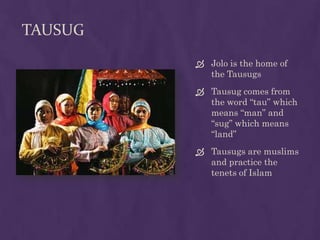Tausug Philippines - The Facts
The Basic Principles Of Tausug Philippines
Table of ContentsThe 5-Minute Rule for Tausug PhilippinesThe Greatest Guide To Tausug PhilippinesAn Unbiased View of Tausug PhilippinesTausug Philippines for BeginnersTausug Philippines Can Be Fun For EveryoneExcitement About Tausug Philippines
Anne's perceptions of the Pangalay demonstrate how, in a location where a number of cultures exist together, respect for tribal possession of a dancing is not incompatible with a gratitude for and also a sense of satisfaction in the cumulative corpus of dances as one practice, on a national level. Dancing is an activity so widespread in Philippine culture that, ironically, it is regularly taken for given.
There is no denying that Reyes-Aquino deserved her Nationwide Artist Honor in Dance for the collection of descriptions of all the dancings that show up in her six-volume job (Aquino 1953), but I keep that additional study is required to improve this collection by upgrading, trimming, increasing, as well as correcting, where necessary, specifically when it concerns the category as well as groups of dances.
There is much information therein, absolutely, but reliable reorganization and also dissemination of this info requires the job of much more scholars. I keep in mind, nevertheless, that this procedure of alteration is not without its political problems amongst dance scholars as well as practitioners. Tausug Philippines. While investigating the Pangalay in the resources and two districts of Tawi Tawi, an island province within the Sulu island chain, Santamaria uncovered that the natives of this province separated the Pangalay from the Igal.
The Ultimate Guide To Tausug Philippines
Not remarkably, responses from Amilbangsa's group to this case were aggressive, charging Santamaria of negating Amilbangsa's original study as opposed to watching it as the discovery of brand-new understanding. As the acknowledged professional in Pangalay, it was presumed that Amilbangsa could not be wrong, in the same manner that Aquino's research is believed to be incontestable.
Bajau youngsters learning the Igal in Sempornah, Sabah. Image by Hanafi Hussin. Amilbangsa's advocacy for the Pangalay is worthy because she looks for to keep the custom to life to ensure that future generations will keep performing this old-time type that was practiced before the people that danced it were transformed to Islam.
Clearly, it would be beneficial if she can update her research or permit others to continue the research for her. My account of issues with the classification and also classification of dances in the Philippines and also their documents looks for to demonstrate how the growth of a nationwide heritage is not without contestation, as multiple social teams struggle to keep their identification as well as self-reliance on a tribal degree within the merged field that is nationhood.
The Tausug Philippines Diaries
On the bottom footer of the internet site, a copyright is suggested from 1999-2013, although this might reflect the length of time that the Alun Alun Dancing Click Here Circle has been in procedures, as stated on the web site's account web page: http://pangalaydance. com/the-alun-alun- dance-circle. It would be risk-free to say that the post "The Pangalay Dance Style" may have been posted to the site as early as January 2007, which is the oldest day of the archives of short articles on the site, as well as created prior to after that.
gov.ph, it is unclear where an upgrade of this report can be located. Reviews of the history of Philippine dancing are found in Basilio Esteban Villaruz's Sayaw: An Essay on Philippine Dancing, which was released as a brief essay by the Cultural Facility of the Philippines (CCP) in 1989, after that consisted of in the Tuklas Sining collection (1991 imp source ).
In some areas, the movement of such individuals has dramatically changed the ethnic composition. Such is the instance of southern click to read Sulu, the islands comprising the province of Tawi-Tawi. This paper is a discussion of recent population motions in the Sulu Islands, as well as exactly how these might be connected to the society background of the Sama individuals, the earliest residents of Sulu (*).
Tausug Philippines Fundamentals Explained

Design as well as Neighborhood Planning. There are three kinds of Mranaw residences: the lawig (little house), mala-a-wali (big home), and the torogan or ancestral residence of the datu. Some Mranaw residences have blog posts which rest on the rounded boulders; these "drifting structures" prevent the frameworks from breaking down during quakes (Peralta, 1975: 28-31).
It stands thirty to 220 centimeters in the air, resting on nine to twelve bamboo or wooden posts. A fenced deck works as the front of the house; the kitchen area, which is fifty centimeters lower than the frameworks, is at the back. Tausug Philippines. The text residences the sleeping location, which increases as a living and workspace in the early morning.
Fascination About Tausug Philippines
The widowed line flooring of your house is of split bamboo tied with rattan. Sculpted chests, head boards, or insect screens separate the interior into the sleeping as well as non- sleeping areas. Covered with a riyara woven floor covering, rice-stalk bundles act as bed cushions, the head as well as foot of which are set out with cushions.
The roof of the mala-a-walai is made of thick cogon turf safeguarded on bamboo frameworks by rattan. Notched bamboo posts web server as the stairs, which are placed at the front and back of your house (Alarcon, 1991: 65-66). The finest example of Mranaw design is the torogan, which showcases the finest of Mranaw okir (essentially, "sculpting").

Not known Details About Tausug Philippines
